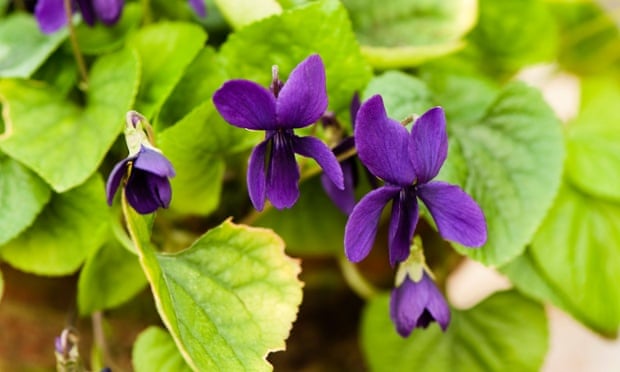Sweet violets are steeped in history and folklore, prized for their fragrance and medicinal uses. Lauded by the ancient Greeks and adored by Napoleon and the Empress Joséphine, their popularity, particularly as a cut flower, reached a height in Victorian and Edwardian times. Dorset, Devon and Cornwall were centres of sweet violet growing and production peaked in the 1930s. You can still see the remains of walled flower fields, known as quillets, on the western tip of Cornwall, where violets were cultivated to send to Covent Garden market. In France, the quest for new varieties with strong perfume, long stems and large flowers led to a craze in plant breeding.
Catching a glimpse of them in the wild is rarer today due to habitat loss. Grow them alongside snowdrops, wood anemones, primroses and lily of the valley to create a piece of spring woodland of your own. And, if you fancy something that packs more punch, or like to grow cut flowers for your home (the best and easiest way to appreciate their perfume), there are a host of stunning cultivars, with larger flowers held on longer stems in a variety of colours.
How to grow violets
Recreate the conditions they love in the wild. They need winter and spring sunshine but summer shade, so the ideal spots are under deciduous trees and shrubs. They used to be grown commercially in orchards, providing fruit growers with a spring crop of blooms to sell before the autumn harvest of apples and pears. As long as the ground doesn’t dry out, grow among herbaceous perennials, since any summer planting will provide sufficient shade.Sweet violets thrive in moist but well-drained soils. Incorporate plenty of leaf mould into your soil, and where drainage is a problem add a little grit to the planting hole. A sprinkling of mycorrhizal fungi on the roots can help them settle in. As they become established, they’ll form clumps, providing useful ground cover with their pretty heart-shaped leaves.
They spread, using runners, in the same way as strawberries. They can be propagated easily from these, as they’ll form roots where they come into contact with the soil. Remove these runners in spring, as they divert energy from blooming. Deadheading prolongs the flowering season as long as possible.
Violets will self-sow, but growing your own from seed can be tricky as the seed needs to be fresh. Specialist growers gather seed in the summer and send it out immediately. Sow these seeds into trays filled with a free-draining seed compost as soon as you receive them. A spell of cold weather is needed to break the dormancy, so leave the trays in a cool greenhouse or cold frame over winter. Seedlings should start to emerge in February or March.
What to grow: heritage violets

‘Princess of Wales’ Introduced by French violet grower Armand Millet at the end of the 19th century. Particularly popular as a cut flower due to its large violet-blue flowers and strong fragrance.
‘Luxonne’ Another French heritage variety and popular cut flower with long stemmed violet-blue flowers and leaves. Good for ground cover.
‘Lianne’ Classic deep purple blooms that are strongly perfumed. First raised in France at the turn of the 20th century to supply florists.
‘Perle Rose’ Unusual pink-red flowers that are produced later than other cultivars, in March and April.
What to grow: new violets
‘Diana Groves’ Established from a seedling at Groves Nurseries, this was a gold-medal-winner at the International Violet Congress in 2004. Striking claret petals with pretty white markings.
‘Annie’ Another award-winning violet from Groves – smaller than some varieties but abundant with flowers in a delightful deep pink.
‘Santa’s Beard’ A stunning white cultivar with a delicate blush of faint purple and attractive veining.
No comments:
Post a Comment